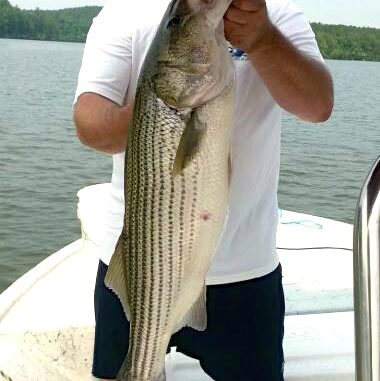
Head upriver and drift live bait for linesides
For striped bass ranging from 12 to 30 pounds this month, guide Joe Jobin of Xtreme Striper Fishing (704-240-0165) spends his time on Lake Rhodhiss, playing in the sand and trees from the NC 18 bridge upstream to the mouth of the St. John’s River.
Along this narrow stretch of river, there’s the “Sand Tracks,” an area where the dredging of sand has created a number of holes plunging as deep as 14 feet surrounded by only 6 to 8 feet of water.
“The stripers settle in these holes to ambush forage when water is being generated from Lake James,” said Jobin.
Before fishing the potholes, Jobin consults the Duke Energy website (www.duke-energy.com/lakes) that provides water-discharge levels from Lake James into Rhodhiss.
“If the discharge runs two units, that’s too fast for effective drifting or trolling,” Jobin said. “It’s best to wait another day to fish. If Duke’s running one unit, that’s perfect for slow-trolling and pulling live shad.”
Jobin also postpones fishing if the area is muddy from heavy rains.
“The water will clear in a few days after Duke pulls the lake,” he said. “A green-colored hue is best for striper fishing with water temperatures in the mid to upper 50s. The fishing is also better during the week than on weekends.”
The other river hangouts for stripers are the numerous tree laps that create current breaks and staging places.
To fish the potholes and tree laps, Jobin sets out one planer board to run past the edges of the trees near the bank and a couple of free-lines out from the back of the boat. The narrow confines of the river makes setting out a second planer board risky.
“The river is only 80 to 120 feet across and shallow,” Jobin said. “If I set out two planer boards opposite one another, a passing boater is likely to take one of them with him.”
Jobin uses 15-pound Stren for his main line, with a 5-foot leader of 17-pound fluorocarbon rigged with No. 6 treble hooks baited with 5- to 6-inch live gizzard shad, hooked through the nostrils. He keeps his bait about 10 feet behind the planer board to weave it around trees without snagging.
Surface action for stripers is limited this month.
As a bonus, fishermen might hook a 3- or 4-pound smallmouth bass while fishing for stripers.
Jobin uses the Castle Bridge Access to reach the river in about 15 minutes.
“There’s a closer ramp, but it’s primitive and for small watercraft,” he said.



